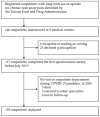Prescription Opioid Use among Patients with Chronic Noncancer Pain before and after the COVID-19 Outbreak in Taiwan: A Multicenter Prospective Observational Study
- PMID: 36553984
- PMCID: PMC9778017
- DOI: 10.3390/healthcare10122460
Prescription Opioid Use among Patients with Chronic Noncancer Pain before and after the COVID-19 Outbreak in Taiwan: A Multicenter Prospective Observational Study
Abstract
Background: The COVID-19 outbreak disrupted medical access for patients receiving chronic opioid therapy. This study investigated their prescription opioid dosages before and after the 2020 outbreak in Taiwan.
Methods: A prospective questionnaire survey was conducted among registered outpatients receiving long-term opioids before July 2019 in Taiwan. The questionnaire included items from the Taiwanese Brief Pain Inventory and quality of life assessment. Follow-up surveys in outpatient departments through October 2020 were conducted to collect opioid prescription data.
Results: After a mean of 531 days, the questionnaire responses of 103 of the initial 117 respondents were reviewed. Daily opioid doses decreased for 31 respondents (30.1%), remained roughly equivalent (defined as ±2.5%) for 27 (26.2%), and increased for 45 (43.7%) after the first wave of the pandemic. The use of strong opioids and nonopioid medications did not significantly differ among the three groups, but less fentanyl patch use was noted in the decreased-dose group after the outbreak. More than 70% of the patients received daily high-dose opioids (≥90 morphine milligram equivalents); moreover, 60% reported constipation. No deaths due to opioid overdose occurred during the study period.
Conclusions: The COVID-19 outbreak in 2020 did not interrupt access to long-term opioid prescriptions for most registered patients with chronic pain in Taiwan. Less fentanyl patch use was observed in participants whose opioid dose was tapering.
Keywords: COVID-19; chronic pain; noncancer; opioid; prescription.
Conflict of interest statement
The authors declare no conflict of interest.
Similar articles
-
Long-term use of opioids in 210 officially registered patients with chronic noncancer pain in Taiwan: A cross-sectional study.J Formos Med Assoc. 2017 Apr;116(4):257-265. doi: 10.1016/j.jfma.2016.10.015. Epub 2016 Dec 23. J Formos Med Assoc. 2017. PMID: 28024664
-
Gender Differences in Depression and Sex Hormones among Patients Receiving Long-Term Opioid Treatment for Chronic Noncancer Pain in Taiwan-A Multicenter Cross-Sectional Study.Int J Environ Res Public Health. 2021 Jul 23;18(15):7837. doi: 10.3390/ijerph18157837. Int J Environ Res Public Health. 2021. PMID: 34360130 Free PMC article.
-
Fourth Wave of Opioid (Illicit Drug) Overdose Deaths and Diminishing Access to Prescription Opioids and Interventional Techniques: Cause and Effect.Pain Physician. 2022 Mar;25(2):97-124. Pain Physician. 2022. PMID: 35322965 Review.
-
Responsible, Safe, and Effective Prescription of Opioids for Chronic Non-Cancer Pain: American Society of Interventional Pain Physicians (ASIPP) Guidelines.Pain Physician. 2017 Feb;20(2S):S3-S92. Pain Physician. 2017. PMID: 28226332
-
Opioids and the management of chronic severe pain in the elderly: consensus statement of an International Expert Panel with focus on the six clinically most often used World Health Organization Step III opioids (buprenorphine, fentanyl, hydromorphone, methadone, morphine, oxycodone).Pain Pract. 2008 Jul-Aug;8(4):287-313. doi: 10.1111/j.1533-2500.2008.00204.x. Epub 2008 May 23. Pain Pract. 2008. PMID: 18503626
Cited by
-
Assessment of opioid knowledge and attitudes among senior medical students in Taiwan's pain education curriculum: A cross-sectional questionnaire survey.BMC Med Educ. 2024 Sep 27;24(1):1045. doi: 10.1186/s12909-024-06043-4. BMC Med Educ. 2024. PMID: 39334303 Free PMC article.
-
Knowledge, attitudes and practices of pain management among Taiwanese physicians in a reformed 2-year postgraduate training programme: a cross-sectional questionnaire survey.Ann Med. 2025 Dec;57(1):2466671. doi: 10.1080/07853890.2025.2466671. Epub 2025 Feb 22. Ann Med. 2025. PMID: 39985191 Free PMC article.
References
-
- National Institute on Drug Abuse Overdose Death Rates, 1999–2020. [(accessed on 15 July 2022)]; Post on 20 January 2022. Available online: https://nida.nih.gov/drug-topics/trends-statistics/overdose-death-rates.
-
- The Draft 2022 CDC Clinical Practice Guideline for Prescribing Opioids Was Posted for a 60-Day Public Comment Period (from 10 February 2022 to 11 April 2022) [(accessed on 15 July 2022)]; Available online: https://www.cdc.gov/opioids/guideline-update/index.html.
Grants and funding
LinkOut - more resources
Full Text Sources


